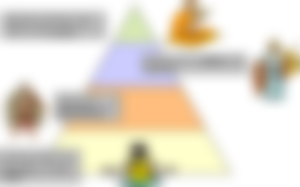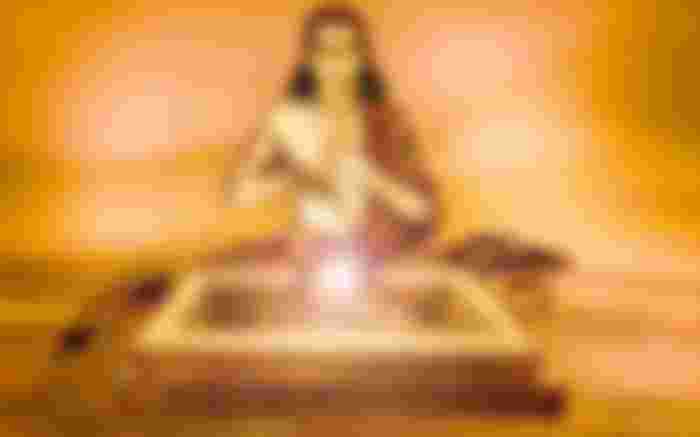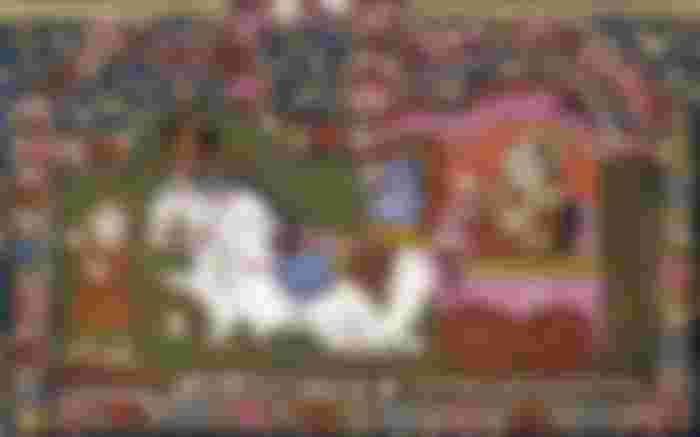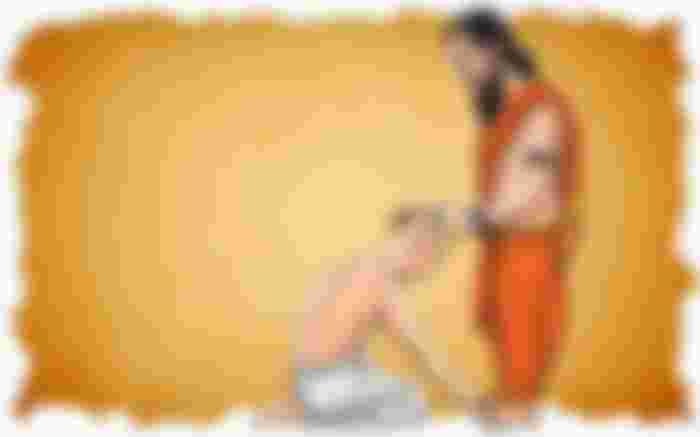At the beginning of the second millennium BC, the Aryan tribes entered India from the north-west. They established themselves by defeating the local urban civilization. The suktas of the Rigveda have the shadow of this conflict. Many of the non-Aryans acted on behalf of the Aryans out of fear, devotion or greed. The monkey army of Rama's side in the Lanka war, Hanuman, Jambuban, Sugriva - all are native people. However, since its entry into India, the work of composing the Vedas, a collection of theological and philosophical inquiries, has been going on for several centuries. That long period is known as the Vedic age in Indian history.

The Indus Valley Civilization was pre-Aryan. Naturally, agrarian civilization will be maternal. On the other hand, the main occupation of Aryans is animal husbandry. Cow is one of the animals again. The tribal society formed for the sake of hunting and animal husbandry is patriarchal. Conflicts were normal in both cultures according to inheritance. The name Ganges is found at the very end of the Vedic code. That is, the Aryans expelled the non-Aryans and gradually advanced towards the east. Moreover there is no discussion of rice anywhere except in the Atharva Veda; There is talk of barley. Seen in this way, the existence of a new social system is visible; The main document of which is the Veda itself.
Caste
India today is desperate to get rid of the curse of that caste system; It was not created at the beginning of the Vedic age. At the end of the Aryan vs. Non-Aryan conflict, the defeated non-Aryans became slaves of the Aryans or fled and became bandits. The reason for the bandits is that they would try to recover the lost property whenever they had the time and opportunity. As a result, there were only two castes till then - Aryan and non-Aryan.
Later cognitive development began. An educated class was formed. Since there was no practice of writing, education was used to refer to oral knowledge. That is why another name of Veda is Shruti. They occupy a part in the structure, teaching and practice of the Vedas. Gradually knowledge became more popular than action; And the dominance of the educated class continues to grow. These were later recognized as Brahmins. They keep the reading and practice of the Vedas in their hands. In this case the ruling class gives patronage. Because it is significant to be able to add religious legitimacy to the worldly power of the ruler. Brahmins are capable of possessing that ability to add. As a result, the second class of society, Kshatriyas, was formed with those rulers and heroes.

Vidyan Brahmins and the heroic monarchy are a small part of society; Most are out of this cycle. They are not in the pursuit of knowledge, nor in the monarchy. They are merchants, workers and farmers. He lived on the ground floor of the society. There was no recognition and no strength to stand up. But they are the basic foundation of the financial foundations of that society. Their name is Vaishya. Thus only the Aryan part is divided into three parts. The non-Aryans have broken down economically, socially and politically as Shudras. Earlier Brahmins were determined by action. Later it went to the clan title. The rest of the similar classes are the regulatory economic system of birth, but the clan has been the latter.
Monarchy
Although the Aryans are nomads, they have mastered the culture of the local urban civilization well. Villages and cities developed. The Rig Veda mentions a well-governed mayor. That monarchy was established in the Vedic age; Good evidence of this is found in the Vedas. In the Rig Veda, two suktas written for the king are 10/173 and 10/174. In some cases the king was elected. However, there is also evidence that kings have ruled in the line of descent. In this context 7/8 sukta can be mentioned. There is a king named Devyan, whose son Dibodas and grandson Sudas were kings. Another king named Nahus is mentioned on 7/6 /5. He also used to take taxes. Jayati son of Nahus was also king.
The ancient tribal society was governed by panchayats. Sardar and Moral were selected for small groups. The meeting was responsible for governing the higher organization. The subject of this meeting has come up in various ways in the Vedas. In fact, economic development has made the tribes more militant; So much so that tribal democracy has become extinct. The monarchy has raised its head from its ruins. Indra, the god of war, prevailed. That final form of the rise of monarchy is seen in the Mahabharata.
The influence of religion
Pets in that era, Aishwarya, heroic men, long life, great; The sages used to pray to the gods through mantras for grains etc. The relationship between gods and humans was simple. Vedic religion is naturally sacrificial. Brahmin priests appeared as a link between the king and the gods in religious ceremonies. It was believed that the declaration of inevitable wars and the prayer for victory depended on it. As a result, the priests were not only at the center of religion; Was at the heart of politics.

Rigveda worships the deities when a deity is praised; Then he is not praised as a small or finite deity. Is done in the form of Almighty God. This feature demands discussion. In ancient Greece, the gods were thought of as finite beings with small powers. Not imagined as the Supreme God or the Supreme Being. This is why Greek theism is called Polytheism or polytheism. For example, Zeus is considered to be the god of Greece. But there is no concept of omnipresent omnipotence that transcends the personality of individual deities. This exists in the discussion of the Vedas. Maxmারller called this feature Henotheism. I.e. when that deity is worshiped; It is in the form of God. As mentioned,
Ekang satbipra bahudha badanti
Agning yam matarishvanmahu
That is, the Vipragans call an absolute being Agni, Yam, Matrishva, etc. by various names.
This theism of the Vedas is the main source of the monotheism of Vedic religion and philosophy. The primitive Aryans imagined divinity in the various beauties and energies of nature. Later that whole thought merged into the existence of an omnipotent Creator. The progress of the thought-consciousness of the sages in ancient times is astonishing.
Livelihood
The main source of livelihood of the Aryans of the Vedic period was cow-rearing and agricultural work. The famous ‘Axis’ sukta of the Vedas condemns gambling and praises agricultural work. It has been said, ‘Do not play dice, do farming. There will be a lot of respect and wealth in the agricultural work. So the sage's prayer to the gods is seen, that Godhan should not be killed by the tiger. Do not be destroyed by a waterfall.
There were many forests in the Vedic period. Attacks by tigers and other ferocious animals are therefore a daily occurrence. There is a problem of cows or calves getting lost in the deep forest. The sages therefore prayed that the milking cows should not be separated from the calves and move to inaccessible places. The Aryans also learned the method of grain production. The system was artificial irrigation. The Vedas speak of both natural and artificial irrigation. E.g.,
‘Apo Divya Utvasravanti
Khanitrima utba yah swayangjah
Samudartha yah shuchayh pabpasta
Apo debirih sambastu ..
In the above mantra, khanitrima means artificial irrigation and the word swayangja means natural irrigation.
Art
There was a great demand and supply of gold in the Vedic age. Ordinary people also wore gold ornaments. The kings and emperors used to make chariots from their thrones with gold. The temples of the gods were decorated with gold. Since animal husbandry was established as one of the occupations of man; Animal skins have also been used for various purposes. Leather industry was the means of livelihood for many. There was the use of rope and yarn. On the other hand, the beginning of the Vedic age was the beginning of the Iron Age of ethnographic division. From there people learned to use iron. Iron was widely used in the manufacture of various weapons and furniture.
The Aryans were able to build high quality vessels, especially ocean-going ships. Evidence of this is found in many mantras. The 10/143/45 mantra speaks of the ship as a whole. The large marine boat was called Sairabati boat. As a war-torn nation, they often had to engage in war. As a result, there are many examples of iron, gold and stone weapons. Indra has a description of a thousand thunderous thunderbolts. There is talk of making axes and bows.

In the old days the main vehicle was the chariot. Which is now known as the horse-drawn carriage; Rath is his ancestor. The chariot is unrivaled in everyday use from battlefield. Horses, mules, cows or donkeys were considered as vehicles, but horses were considered as the best. Chariot making therefore became a respectable profession in the old days. The description of the well-built chariot is quoted in various mantras of the Rigveda.
Food and drink
There is a lot of information from the Rig Veda about food and drink in the past. 5/85/3 Sukta mentions barley. Although there is no mention of paddy in the beginning of the Veda, it is mentioned in the Atharva Veda at the end. Meat was widely used as food. Taurus meat, buffalo meat or aj meat was eaten 1/162/3). In Satpatha Brahman, bulls, male goats or barren cows have been sacrificed. Cow's milk and ghee made from it were on the favorite list. Sage Yajnavalkya says, ‘Ashnami prabamahamangsalang chetbhavati’ means if the beef is tender; But I will bring and eat. '3/2/21
Among the drinks, honey, liquor and sourdough were the main ones. When Shaundik was there, there was also the use of alcohol. However, in the Aitareya Brahman the praise of Somaras and the condemnation of Sura have been explicitly stated. Somalta juice is recognized as the favorite drink of the gods just like ghee. So I see an entire chapter full of Monday's praises. Mon was not only provocative, it was thought to increase longevity (6/48/11). But like the river Saraswati, it has disappeared. How such a dear creeper got lost is not understood.
Education system
In the society of that time, upanayan would have taken place only if the male child had spent his childhood and entered adolescence. Upanayan is the preparation to go to the Guru's house. The first birth of a child in the mother's womb; The second birth is this upanishad. As a result, the names of the male children after Upanayan were Dwij or second born person. The spiritual explanation of Upanayan initiation is found in Satpatha Brahman. Through this the student's right to read the Vedas was born.

The student had to appear before the teacher with humility and reluctance. The study of Vedas and the teaching of ancillary rules continued. There is an explanation in Satpatha Brahman as to why the student had to beg. In this way, shame and arrogance are removed from the inside and a sense of humility is created. First of all, don't be discouraged; The first thing he has to do is to beg from the Acharya's wife and his own mother. The begging of the Vedic students was mainly done in Anaryapara. Usually no one would refuse to beg for fear of falling into Devrose.
In the Vedic age, the entire educational life had to be spent in the Gurugriha. This period is sometimes up to twelve years. Literature, grammar, religious rituals, Sanhita, Brahman, Aranyaka, Upanishads and Bedanga were read. Of course more topics are attached later. At the end of his education he had to bathe in the Ganges in a special process. Students who returned home after bathing were called graduates. Convocation used to say to come back home after education Even today the words graduation and convocation are used in the university.
Entertainment
Sports were not as popular then as in modern times. Still horse races and chariot rides continued. The game of dice was known as one of the domestic games. How devastating the dice were; This is proved in the story of losing all the warriors in the Mahabharata.

In the Aryan era, fine bananas were in vogue. Priests chanted hymns during the exhalation of Sommers. The Rik Sanhita mentions various musical instruments such as Thanda, Karkari, Dundavi, Shatatantri, Ban, Banshi etc. Veena and Ban are two of his associated musical instruments. Playing the ban was considered to be the work of a skilled musician. Sugarcane palms were played during ordinary dances. At that time two types of harps called Pichola and Iduswari were seen.
Some of the mantras of the Sanhita speak of dance. Usually there is mention of dancing with bamboo sticks. At present similar dances are prevalent among the various ethnic groups of West Bengal and Bangladesh. The girls still dance with the sound of bamboo sticks and various musical instruments. The news verses of the Rik Sanhita are the source of the drama.
Before the end
There was a trend of crime at that time as well as today. In society, just as there are pious people, there are also dishonest ones. The Rick Code mentions robbers, thieves, alcoholics, and gamblers. There is also talk of a society where they are forbidden. There was also an adoption system in Aryan society. However, most adopted sons would leave their parents when they grew up. As a result, the practice was not very pleasant. There were selfish and generous people in the society.
The way of life of the nomadic Aryans is varied. Defeating a permanent civilization did not just fly the flag of their own domination over it. The currents of religious thought, politics, society and culture have changed by adapting to the new environment. The most well-known example of the status of non-Aryans in the new social system is the consequence of Eklavya mentioned in the Mahabharata. In addition, the Aryans themselves were divided into several sects. Many superstitions have taken root in the grip of time and selfishness. Yet the same is true of all diversity; They have taken over that land for centuries.
Thanks
If you like it Upvote Can give.






very great article my dear I have subscribe you